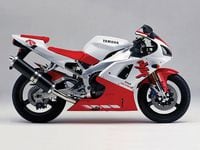In the '90s and early '00s, liter-class sportbikes were king. They represented the apotheosis of technology and the pride of their makers. They were emblems of a high time—an age of excess before the hit of stark realities. What the roaring twenties were to the wider world, the early '00s were to the sportbike enthusiast. The motorcycle industry was staring down the barrel of a global economic recession, the devastation of earthquakes in Japan, and a younger generation more interested in pixels and joysticks than bug-splattered visors and twistgrips. When it all came crashing down, unless you were a die-hard enthusiast, tire-smokin' horsepower started to look crass.
After the economic recession of 2008, the development cycle of Japanese sportbikes slowed drastically, American roadracing hit a long-time slump when DMG took control, and EPA and international regulations hampered the pursuit of unfettered performance.
Thankfully, the European manufacturers kept the sportbike torch lit as the Japanese bikes, with their “bold new graphics,” started to look like the leftovers in your fridge that fail to be as appetizing the second (or third or fourth…) time around.
These days, there’s a lot to be excited about as the Japanese manufacturers are releasing new liter-class sportbikes, including halo models, like the Kawasaki H2R, and higher-spec homologation models like the GSX-R1000R et al. Ever-advancing electronic rider aids are making sportbikes safer, even as horsepower figures continue to climb. The manufacturers are evolving and investing in new ways to entice first-time, young motorcyclists while still developing cutting-edge technology for long-time enthusiasts.
So, things are looking good. But for the sportbike world, the late ‘90s to early ‘00s remains a pivotal era of rapid technological development that changed racing regulations and created the modern-day superbike as we know it.
The era began with the transformation of bloated, big horsepower open-class machines into bikes that were also lithe and balanced, attributes that until then were more characteristic of 750 superbikes. It’s ironic that the bike that is in many ways responsible for this sea change, the ‘92 Honda CBR900RR, started its development life as a 750. Tadao Baba’s original Blade recast the definition of speed. Baba-san’s mantra of “total control” prioritized power-to-weight ratio over outright horsepower, making overall performance the highest virtue.
The turbo that is the Japanese motorcycle industry was spooling up in response.
As if to presage the coming of a new millennium, Yamaha released the 1998 YZF-R1 with its electric-smooth engine and fifty/fifty weight distribution, all wrapped up in svelte futuristic bodywork. It threw down 131.4 hp on Motorcyclist’s dyno, which was roughly the same as the YZF1000R. Here’s the kicker: it weighed an astonishing 58 pounds less than its predecessor. 58! The gauntlet was thrown.
While liter bikes were shedding weight faster than a Middle American obsessed with the Jenny Craig Diet and Slim Fast bars, horsepower figures climbed ever higher.
In the March 2001 issue of Motorcyclist, Mitch Boehm says, "we're dealing with what might very well become a whole new performance benchmark for open-class Supersport motorcycles." He was speaking of the new for '01 Suzuki GSX-R1000: 10 pounds lighter than the R1 and with 10 more horsepower to boot. As a point of reference, the Gixxer-thou was an astonishing 117 pounds lighter than the old 1100.
The rate of development reached a fever pitch as the OEMs embarked on a veritable game of one-upmanship, each trying to be lighter, faster, and more powerful than its competitors. After 1998, the R1 was updated in 2000, 2002, 2004, 2007, and 2009. The big Gixxer was updated every odd-numbered year between 2001 and 2009. It was the same for Honda and Kawasaki.
The early ‘00s were so exciting because it seemed like we were reaching the apex of mechanical innovation. It was still possible through clever thinking and the application of newly-developed materials and manufacturing processes to drop huge weight in one model year and edge ever closer to the knee-dragging, wheel-hoisting sublime. These days, that kind of rapid progress is unimaginable. It’s all about whittling down a few ounces here and a few grams there. Even in clean-sheet designs, it’s increasingly difficult to make huge gains.
The most significant area of innovation of the last decade is in electronic rider control aids. With little black boxes and 0s and 1s, this type of advancement is a little less tangible and romantic than high-lift cams, titanium valves, and stacked gearbox shafts. Perhaps it’s because we are an obtuse people, but bikers like hard parts.
Without being overly nostalgic, there was something special about the era. Maybe it's just because I was coming of age at the time, but I don't think that's entirely the case. The era represents a spirit of endeavor, competition, and admirable single-mindedness. The bikes remain emblems of engineering achievement in the pursuit of mechanical perfection. They are swooping metal and plastic sculptures of speed. Motorcyclists may not need such superlative levels of power and performance, but for many of us, riding a motorcycle isn't about necessity.
There's something about our current day in age that suggests we should apologize for seeking performance for its own sake and with disregard for other qualities. Back then, we were so excited that we could have skyrocketing redlines, vise-like binders, and neuro-wired handling that we forgot to ask if we should. And that's a good thing.











/cloudfront-us-east-1.images.arcpublishing.com/octane/LTME6I3OIYBVISKAR6OBAFUWVQ.jpg)




/cloudfront-us-east-1.images.arcpublishing.com/octane/G4MG6OUCJNBSHIS2MVVOTPX65E.jpg)
/cloudfront-us-east-1.images.arcpublishing.com/octane/IIGGWFOTOJGB7DB6DGBXCCMTDY.jpg)
/cloudfront-us-east-1.images.arcpublishing.com/octane/QSTCM6AVEZA5JJBUXNIQ3DSOF4.jpg)
/cloudfront-us-east-1.images.arcpublishing.com/octane/U4I7G625B5DMLF2DVIJDFZVV6M.jpg)
/cloudfront-us-east-1.images.arcpublishing.com/octane/B6XD6LS6IVCQPIU6HXDJSM3FHY.jpg)
/cloudfront-us-east-1.images.arcpublishing.com/octane/ICL63FEDDRDTTMINYICCEYGMDA.jpg)
/cloudfront-us-east-1.images.arcpublishing.com/octane/FCGZHQXRBZFLBAPC5SDIQLVF4I.jpg)
/cloudfront-us-east-1.images.arcpublishing.com/octane/WNOB6LDOIFFHJKPSVIWDYUGOPM.jpg)

/cloudfront-us-east-1.images.arcpublishing.com/octane/X33NU3E525ECRHXLNUJN2FTRKI.jpg)
/cloudfront-us-east-1.images.arcpublishing.com/octane/6KKT5NNL2JAVBOXMZYS5ZO76YA.jpg)
/cloudfront-us-east-1.images.arcpublishing.com/octane/J5RKG5O455GMPGQRF2OG6LRT7A.jpg)
/cloudfront-us-east-1.images.arcpublishing.com/octane/GX2CIZKQVRH2TATDM26KFG2DAE.jpg)
/cloudfront-us-east-1.images.arcpublishing.com/octane/ZWIDYSAKQZHD5BHREMQILXJCGM.jpg)
/cloudfront-us-east-1.images.arcpublishing.com/octane/CYUHJZCTSJCH3MRAQEIKXK7SCQ.jpg)
/cloudfront-us-east-1.images.arcpublishing.com/octane/LKOFINY56FCXJCANJ5M7ZDQUBY.jpg)
/cloudfront-us-east-1.images.arcpublishing.com/octane/4NBPDACMWJH63JQYJVK3QRBDZI.jpg)
/cloudfront-us-east-1.images.arcpublishing.com/octane/KKHQHRR3FJGX7H2IPU6RALMWG4.jpg)

/cloudfront-us-east-1.images.arcpublishing.com/octane/5IOFS5JAE5FOXMNA23ZRAVVYUU.jpg)
/cloudfront-us-east-1.images.arcpublishing.com/octane/CGXQ3O2VVJF7PGTYR3QICTLDLM.jpg)

/cloudfront-us-east-1.images.arcpublishing.com/octane/OQVCJOABCFC5NBEF2KIGRCV3XA.jpg)
/cloudfront-us-east-1.images.arcpublishing.com/octane/OPVQ7R4EFNCLRDPSQT4FBZCS2A.jpg)